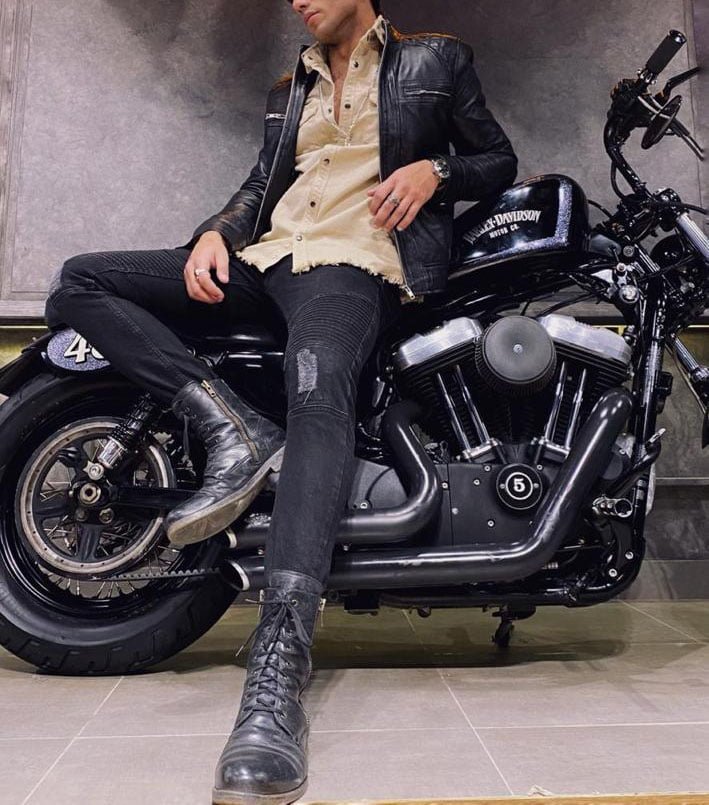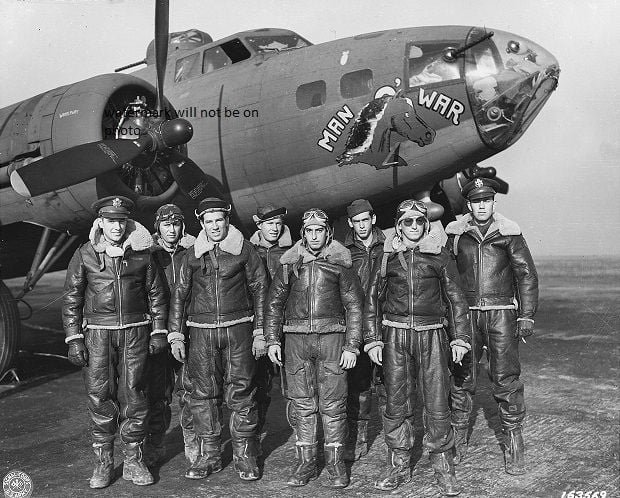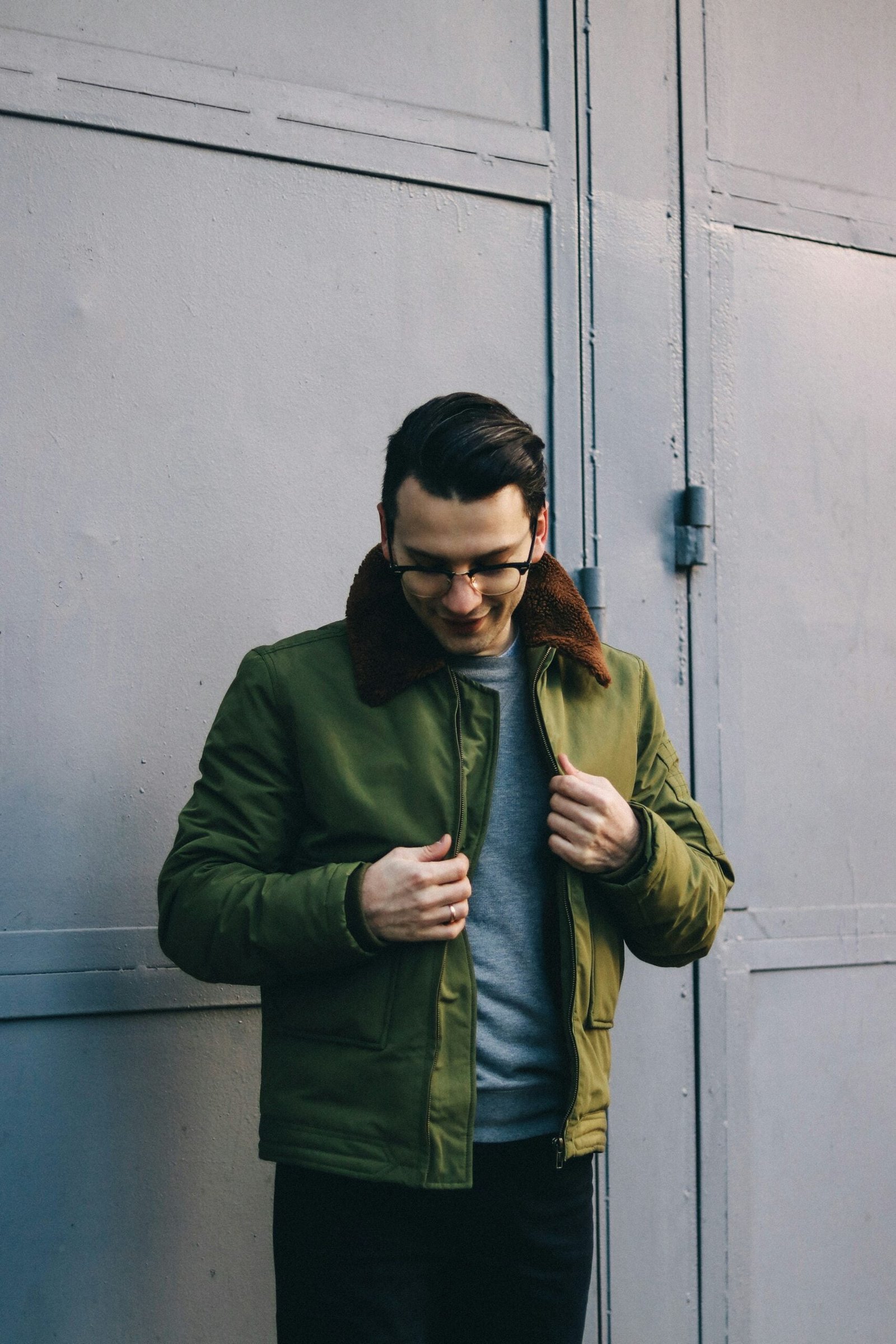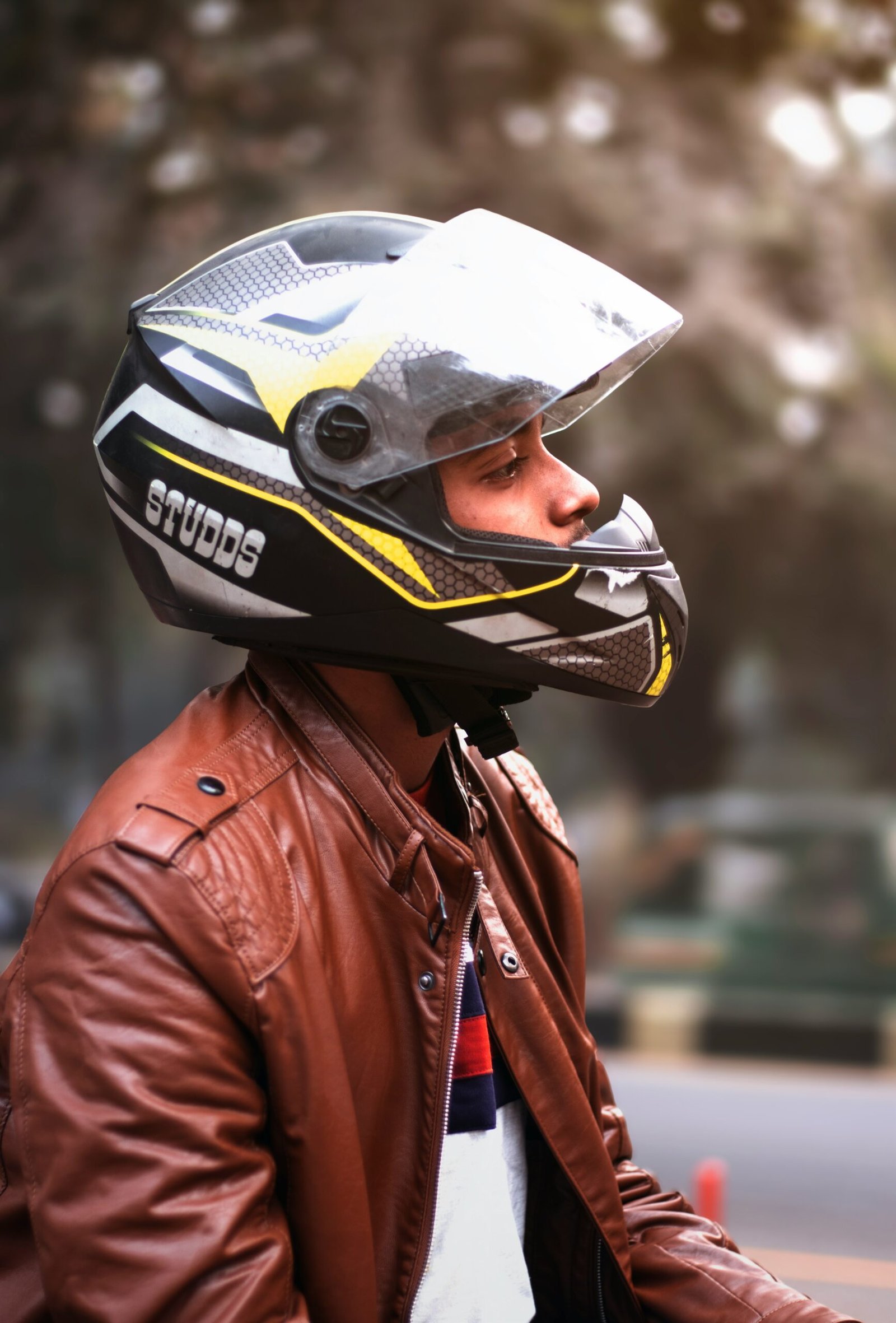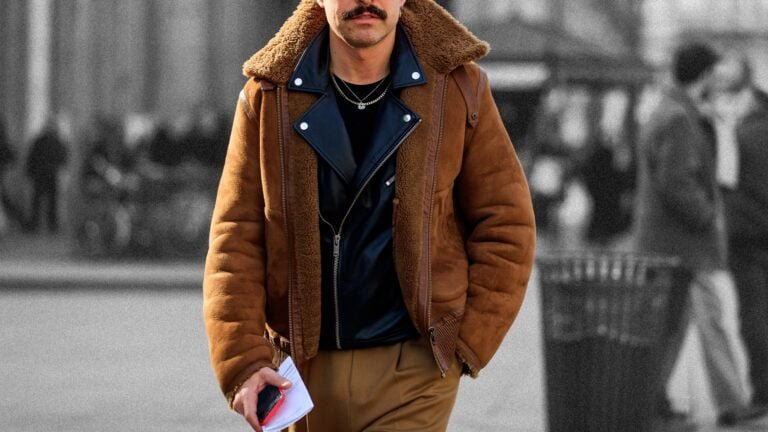What is a Men’s Biker Jacket?
Introduction to Men’s Biker Jackets
Men’s biker jackets, often synonymous with rugged style and rebellious spirit, have a storied history that intertwines with the evolution of motorcycle culture. Originating in the early 20th century, these iconic garments were initially designed for practical purposes, providing protection and comfort to motorcyclists.
As the popularity of motorcycles surged, so did the prominence of biker jackets. By the mid-20th century, they had transcended their utilitarian roots to become a staple in men’s fashion, thanks largely to their adoption by Hollywood rebels such as Marlon Brando and James Dean. These jackets embodied a spirit of rebellion and individualism, capturing the imagination of a generation eager to break free from societal norms.
The defining features of a men’s biker jacket are both functional and stylistic. Key characteristics include the distinctive asymmetrical zipper, which not only adds a unique visual appeal but also offers enhanced wind protection while riding. The use of sturdy materials such as leather ensures durability and resistance to abrasions, making these jackets a reliable choice for motorcyclists. Additionally, many biker jackets incorporate protective features like padded shoulders and elbows, further underscoring their practical origins.
Beyond their practical benefits, men’s biker jackets have become a versatile fashion statement, embraced by various subcultures and mainstream fashion alike. Today, they are available in a myriad of styles, colors, and materials, allowing wearers to express their individuality while paying homage to the jacket’s storied past. Whether worn on the open road or as a casual wardrobe staple, the men’s biker jacket remains an enduring icon of style and resilience.

Materials and Construction
Men’s biker jackets are renowned for their rugged aesthetic and functional design, and the choice of materials plays a pivotal role in their overall performance and durability. The traditional and most revered material for these jackets is leather, known for its durability and timeless appeal. Leather biker jackets offer excellent protection against abrasion, making them ideal for riders. However, they can be heavy and require regular maintenance to keep the material supple and free from cracks.
Faux leather, also known as synthetic leather, is a popular alternative. It imitates the appearance of genuine leather but is often lighter and more affordable. While faux leather biker jackets do not offer the same level of durability and weather resistance as genuine leather, they are easier to maintain and can be more versatile in terms of design and color options.
Textile materials, including nylon and polyester, are also widely used in the construction of men’s biker jackets. These materials are typically lighter than leather and offer excellent weather resistance, making them suitable for various riding conditions. Textile jackets often incorporate additional features such as waterproof linings and thermal insulation, enhancing their practicality. However, they may not provide the same level of abrasion resistance as leather jackets.
The construction of a biker jacket is another critical aspect that determines its quality. High-quality biker jackets feature reinforced stitching, often double or triple-stitched, to ensure longevity and resilience under stress. The type of hardware used, such as zippers and snaps, also contributes to the jacket’s durability. Premium jackets typically use heavy-duty metal zippers and robust snaps that can withstand repeated use and exposure to the elements.
Overall, the choice of material and construction methods significantly impacts the performance, comfort, and durability of men’s biker jackets. Whether opting for traditional leather, versatile faux leather, or practical textile, understanding these factors can help in selecting a jacket that meets one’s specific needs and preferences.
Styles and Variations
Men’s biker jackets come in a variety of styles and designs, each with its own unique characteristics and appeal. One of the most iconic styles is the double rider jacket, often associated with the rebellious spirit of the 1950s. This style features a wide lapel, asymmetrical front zipper, and multiple pockets, making it both a fashion statement and a practical choice for riders.
The café racer jacket, another classic, is known for its minimalist design and sleek silhouette. Originating from the 1960s British motorcycle culture, this style typically includes a straight front zipper, a band collar, and a snug fit, offering both comfort and protection for riders. The café racer jacket’s simplicity makes it a versatile piece that can easily transition from the road to casual outings.
In recent years, contemporary designs have emerged, blending traditional elements with modern aesthetics. Designers and brands have experimented with various materials, colors, and embellishments to create unique interpretations of the men’s biker jacket. For instance, some modern versions incorporate textiles like suede or nylon, while others may feature bold colors or intricate embroidery.
Notable fashion houses and designers have also put their distinctive spin on the biker jacket, influencing current trends. Luxury brands like Saint Laurent and Balmain have introduced high-end versions with premium leather and tailored cuts, elevating the garment to a status symbol. Meanwhile, streetwear brands such as Supreme and Off-White have added urban flair through graphic prints and unconventional details.
These variations not only reflect the timeless appeal of the men’s biker jacket but also its adaptability to evolving fashion sensibilities. Whether adhering to classic designs or embracing contemporary twists, the biker jacket remains a staple in men’s wardrobes, embodying a blend of style, functionality, and attitude.
Functionality and Features
Men’s biker jackets are renowned for their robust functionality and essential features that cater to both safety and style. Central to their design are protective elements such as padding and armor. These components are strategically placed in areas prone to impact, like the shoulders, elbows, and back, providing critical protection for motorcycle riders. In addition to padding and armor, the materials used in these jackets often possess high abrasion resistance, which is vital in preventing injuries during a fall or slide.
Beyond safety, men’s biker jackets have evolved to incorporate fashion-forward designs without compromising their functional integrity. Modern iterations of these jackets seamlessly blend protective features with sleek aesthetics, making them versatile for both riding and casual wear. The juxtaposition of rugged protection and stylish design has made them a staple in men’s fashion.
Practicality is another cornerstone of men’s biker jackets. Pockets are a key feature, offering convenient storage solutions for essential items such as keys, wallets, and smartphones. These pockets are typically designed with secure closures like zippers or snaps to ensure contents remain safe during rides. Ventilation is another critical aspect, especially for long rides in varying weather conditions. Strategically placed vents enhance airflow, preventing overheating and ensuring comfort.
Adjustability is also a significant feature in men’s biker jackets. Adjustable cuffs, waistbands, and collars allow for a customized fit, enhancing both comfort and functionality. This adjustability ensures that the jacket can accommodate additional layers of clothing or adapt to different body shapes and sizes, providing a snug fit that does not impede movement.
Incorporating these functional elements, men’s biker jackets serve as more than just protective gear—they are practical, stylish, and versatile, making them an indispensable part of a rider’s wardrobe.
How to Choose the Right Biker Jacket
Selecting the perfect men’s biker jacket involves a careful assessment of various factors to ensure both comfort and style. One of the primary considerations is the fit of the jacket. Biker jackets typically come in three main fits: slim, regular, and relaxed. A slim fit offers a tailored appearance and is ideal for those seeking a modern, sleek look. Regular fit provides a balanced option, suitable for everyday wear, while a relaxed fit offers more room and is perfect for layering during colder months.
Another crucial aspect is the material of the jacket. Leather is the traditional choice for biker jackets due to its durability and classic aesthetic. However, there are also options available in faux leather, textile, and mesh, each catering to different preferences and needs. Leather jackets provide excellent protection and longevity, while textile and mesh options might be more suitable for warmer climates due to their breathability.
The purpose of the jacket plays a significant role in the decision-making process. If the primary goal is fashion, then design elements such as color, detailing, and embellishments become paramount. Fashion-oriented biker jackets often feature unique stitching, zippers, and patches that add to their appeal. However, if functionality is a priority, especially for those who ride motorcycles, the jacket should offer protective features such as reinforced padding, abrasion resistance, and adequate ventilation.
Measuring for the correct size is essential to ensure a good fit. It is advisable to measure the chest, waist, and shoulders accurately. When trying on the jacket, ensure that it allows for comfortable movement and does not restrict arm or shoulder mobility. Checking the length of the sleeves and the jacket itself is also important, as the right length can enhance both comfort and style.
By considering these factors—fit, material, purpose, and sizing—you can make an informed decision and select a men’s biker jacket that perfectly suits your needs and preferences. Whether you’re aiming for a fashion statement or seeking functional riding gear, understanding these elements will guide you to the right choice.
Caring for Your Biker Jacket
Proper care and maintenance of a men’s biker jacket are essential to ensure longevity and preserve its appearance. Different materials demand specific cleaning methods. For leather biker jackets, it’s crucial to use a damp cloth to wipe off surface dirt and a specialized leather cleaner for more thorough cleaning. After cleaning, applying a leather conditioner will keep the material supple and prevent cracking. For textile jackets, a gentle machine wash with mild detergent, followed by air drying, is generally recommended.
Storage plays a significant role in preventing damage to your biker jacket. Always hang the jacket on a sturdy, wide-shouldered hanger to maintain its shape. Avoid exposure to direct sunlight or damp environments, as these can degrade the material over time. For long-term storage, consider covering the jacket with a breathable garment bag to protect it from dust and pests.
Regular inspections and preventive maintenance can extend the life of your biker jacket. Periodically check the hardware, such as zippers, snaps, and buckles, to ensure they function properly. If any parts are loose or damaged, prompt repair is advisable. Small repairs, like reattaching a loose button, can often be done at home, while more complex issues may require professional assistance.
Preventive measures include conditioning leather jackets at least twice a year to maintain their quality. Taking care of minor scuffs and scratches promptly will also help keep the jacket looking its best. For textile jackets, inspecting seams and reinforcements can prevent small issues from becoming larger problems.
By following these care guidelines, you can ensure that your men’s biker jacket remains in excellent condition for years to come, providing both style and functionality whenever you need it.
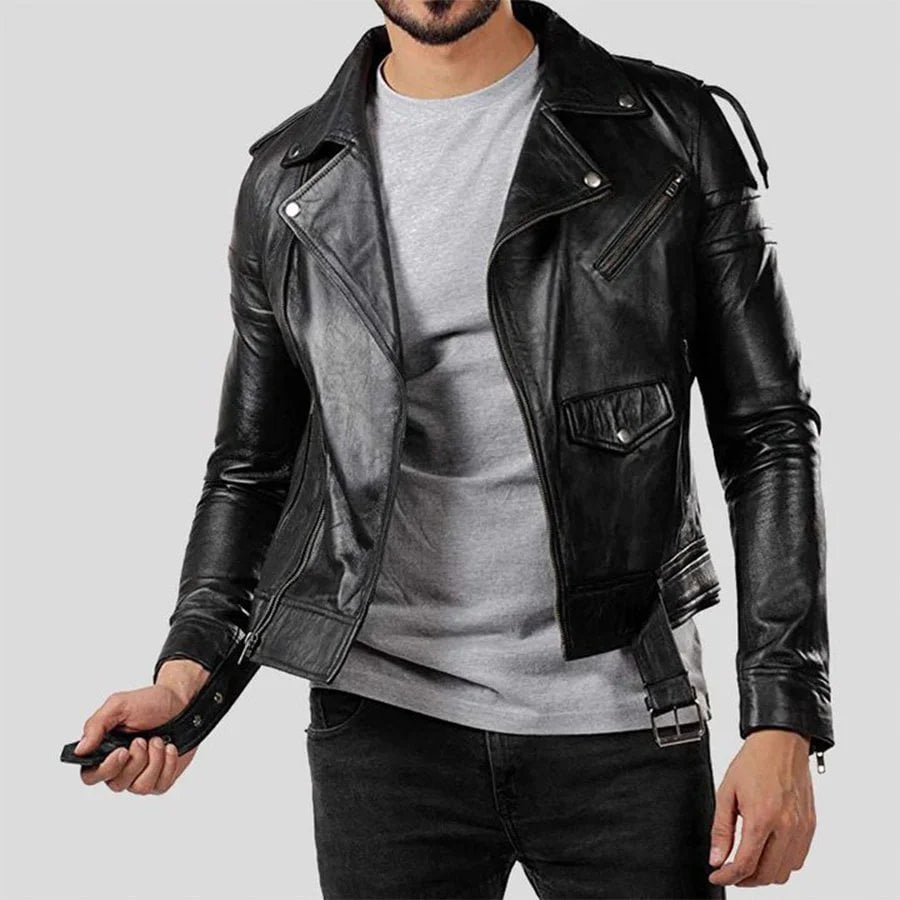
Styling Tips and Outfit Ideas
A men’s biker jacket is a versatile piece that can elevate both casual and semi-formal outfits. When styling for a casual look, pair your biker jacket with a classic white t-shirt and blue jeans. This timeless combination not only exudes effortless cool but also highlights the rugged appeal of the jacket. For footwear, opt for sneakers or boots to complete this laid-back ensemble.
For a more refined, semi-formal appearance, consider wearing the biker jacket over a button-down shirt and chinos. This combination strikes a balance between edgy and sophisticated, suitable for date nights or casual business meetings. Adding a pair of loafers or brogues can further enhance the polished look. Accessorize with a sleek wristwatch or leather bracelet to add a subtle touch of elegance.
When it comes to seasonal styling, the men’s biker jacket proves to be a year-round staple. In colder months, layer the jacket over a turtleneck sweater and pair it with dark denim or wool trousers. This not only keeps you warm but also maintains a stylish, cohesive look. During warmer seasons, opt for lighter fabrics like linen shirts or breathable cotton tees underneath the jacket. Pair these with slim-fit shorts or lightweight chinos for a comfortable yet fashionable outfit.
The versatility of a men’s biker jacket extends to various occasions. For a night out, wear it with a graphic tee and distressed jeans, adding a beanie or cap for an edgy vibe. For daytime events, swap the graphic tee for a simple crew-neck shirt and pair it with khaki pants. This creates a balanced, casual look that is perfect for brunches or casual gatherings.
Accessories play a crucial role in enhancing your biker jacket outfits. Scarves, sunglasses, and hats can add layers of interest and personality to your look. Experiment with different textures and colors to find combinations that reflect your style. By mixing and matching these elements, you can make the most out of your men’s biker jacket, ensuring it remains a versatile and indispensable part of your wardrobe.

